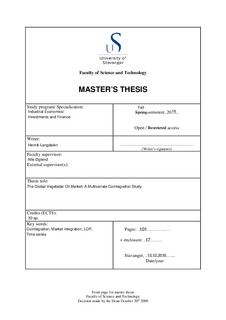| dc.description.abstract | This thesis investigates the existence of one global vegetable oil market. We analyze the historic price developments in the period 2000 until the end of 2015 of fish oil, soybean oil, groundnut oil, sunflower oil, rapeseed oil, corn oil, palm oil, palm kernel oil, coconut oil and linseed oil. The existence of one market can be investigated by the means of Johansen cointegration tests. There is statistical evidence which suggests that there is a strong relationship among the oils in the long-run. The quality of the oils and which end-users the oils have, are the main factors which cause the degree of integration. The general oils (soybean, sunflower, rapeseed and palm oil) which are close substitutes in the cooking and margarine manufacturing are cointegrated over the full period. In addition, the law of one price is accepted for these oils. Tests of all ten oils as in one system rejects the law of one price, but suggests cointegration in the long-run. The lauric oils, coconut and palm kernel oil, are considered as cointegrated and forms a separate sub-market within the global vegetable oil market. Hence, the degree of market integration is strongly linked to the qualities of the oils.
Fish oil has risen to become a premium oil compared to the other vegetable oils. During the commodity boom era, fish oil formed a stationary linear relationship with rapeseed oil. The observed integration between the two can be explained by the degree of substitution of fish oil by rapeseed oil as input in salmon feed – fish oil and rapeseed oil was substitutes in this period, despite fish oil’s premium qualities as a source of Omega-3. There is a break around June 2011 which caused rapeseed oil (and the other vegetable oils) to diverge from fish oil. The high price of fish oil in the recent years is deemed as a result of high demand of fish oil in a new Omega-3 market for human consumption. Thus, fish oil is no longer considered as integrated with the vegetable oils. The high prices of fish oil has caused the salmon feed costs to increase, as fish oil is an important input in the feed. The demand of fish oil is believed to be high in the future, both from the aquaculture industry and the Omega-3 market. Therefore, we believe that the price of fish oil will be traded at premium compared to the vegetable oils in the future. | nb_NO |

